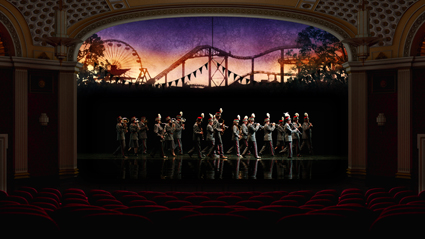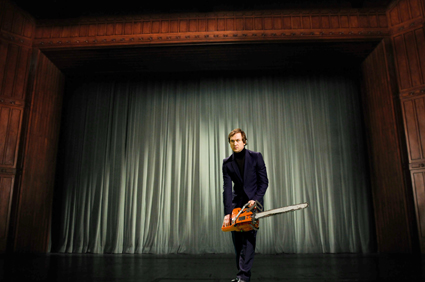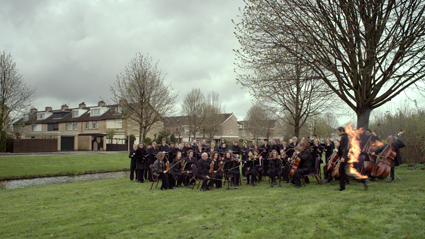Audiovision: Pseudo-cinema & deus ex musica
Philip Brophy: ACCA, Crescendo

Hans Op de Beeck, Parade, 2012 courtesy the artist and of Ron Mandos Gallery, Amsterdam/Rotterdam
I give you no build-up—and certainly no crescendo—when I state upfront that the musically oriented ‘film art’ works in the Crescendo exhibition at ACCA do not contribute to the intersecting fields of musicology, music history or the politics of music. They certainly merge cinema, theatre, music and opera—but in ways so blunt as to short-circuit any imaginative consideration by artist or audience as to what music can specifically bring to such expanded/meta-media works.
Focusing on three of the exhibition’s ‘moving image’ videos which lean heavily on musical incorporation—and which have played extensively overseas, attracting a trail of dumb criticism by visual art reviewers attempting to discuss the works’ use of music—I aim to explicate what these works belie through their fawning and flaunting of musical sensation, music history and musical attitude.
Forensically, one can audit and diagnose the works in Crescendo as accurate reflections of the curatorial templates which sow the contextual fields for these works to thrive. Hans Op de Beeck’s Parade (2012) looks like a trailer from SBS World Movies celebrating diversity and community. A ‘parade’ of people from all walks of life move in controlled groups from left to right across a huge stage housed in some 19th century theatre. It’s full of cute deus ex machina reveals, with digitally composited layers and changing background scrims (the look of old theatre craft meets the pull-down menu of digital cine-fx), and it coyly plays with ‘the viewer’ by situating you in one of the onscreen plush red chairs. Parade espouses this limp politics of aesthetics (of both traditional and virtual art making), causing the momentum of its parading folk to feel smarmy, forced and fatuous.
The music for Parade is an equally limp brass-band composition that daintily skips along, lip-curled, embracing its po-mo light pomposity. Its repetitive ditty harmonises with the clinical precision by which the ‘demographic’ caricatures perambulate across the stage like flaneurs trapped in a new ad campaign for, well…anything. Parade is symptomatic of a fine art anthropology which generates ‘drag documentaries’ which lay claim to representing the socio-cultural breadth of people who comprise everyday life. Old people on mobile phones; a playful youth scout group; a troupe of airline flight attendants; a toughie with a pit-bull; a happy toddler. But in this sanitised domain of a mock public park, we get an antiseptic, market-researched depiction more closely aligned to those faceless people depicted ‘inhabiting’ the urban-planned spaces of architects’ concept billboards for new developments. It’s frightening.
: 
Julian Rosefeldt, My home is a dark and cloud-hung land, 2011; courtesy the artist & Arndt Berlin
Julian Rosefeldt’s My home is a dark and cloud-hung land (2011) scares in a different way. The title refers to a famous German poem (I’m told in the film); the film unfolds as a textual investigation (always flatulent and grandiose) of the power of the forest in the German imagination. Again, the film told me that. In fact, anything in the film, I’m told about. By an introductory narrator; by a painfully upper-middle class couple who quote German poetry; and by a bombastic arsenal of Steadicam tracking shots across extended theatrical set-ups and gathered ‘creative’ personnel, emblematic of the ‘inventive’ mise en scène which is now de rigueur for any trumped-up contemporary opera production included in international arts festivals worldwide. (There’s even a scene with a guy onstage wielding a chainsaw in front of opera literati.)
My home—like the bulk of the works in Crescendo—speaks to an unbearably turgid Germanic mind-set, the kind that arguably still controls the political rhetoric of European art biennales, which compresses Schopenhauer and Beuys (they’re really not that different) into a supposedly meaningful rumination on art, beauty, life and politics. Not surprisingly, My home originates from an exhibition about the German imaginary (How German Is It? Judisches Museum, Berlin, 2011), so everything in the work reeks of that discursive domain: its ironic, deconstructive view of nature (expensively filmed in sumptuous clichés so it’s neither ironic nor deconstructive); its radicalised embrace of artifice (rendered conservative by employing tropes identical to the most mundane music videos and beer advertisements); its pan-mythological sweep of cultural iconography referencing the German forest (flattened by the staging and direction which is on par with reading a Wikipedia entry on the topic). And there’s opera, to be sure. Bad, crappy, faux-Romantic, not-even-camp, time-warped, unmemorable. I felt like I’d taken Mogadon and was watching Ken Russell’s Mahler (1974). In a bad way.

Guido van der Werve’s Nummer veertien: Home (2012)
courtesy the artist
Guido van der Werve’s Nummer veertien: Home (2012)
More expensive production values are discreetly touted in Guido van der Werve’s Nummer veertien: Home (2012). It’s another textual poem (like just about all film art of the last decade) that blithely goes about its cinematic business as if film history had not already investigated the terrain half a century ago. The premise of Home is simple: an introductory title tells the sob story of Henri Chopin’s heart being in Warsaw while his body is in Paris. Cue mournful narrative of displaced cultural identity and selfhood following the tragic separations caused during wartime. Throw in references to Alexander the Great, and stir gently to suggest how Europe’s historical despotism has created its modern diasporas. Top with a ‘performance art triathlon’ by van de Werve who moves from Warsaw to Paris through elliptical and ‘surreal’ sequences to ferry a cup of earth from Chopin’s home in Warsaw back to his grave at Père Lachaise in Paris. I felt like I was either reading van de Werve’s submission to produce the work or his acquittal on receiving a grant. The cinematic or video-specific experience seemed incidental by comparison.
The original score (often performed live onscreen in extended takes) is more engaging than the scores for either Parade or My home, but over 54 minutes it remains stubbornly monotonal, creating an emotional flat-line which neither deepens the triathlon performance nor textually relates to the complex chromatic nature of Chopin’s eclectic compositions which site him between arch Romanticism and a sprouting Modernism. The result is a series of chamber choir passages which signpost the narrative structure without either deep parallelism or audiovisual counter-point. While I suspect Home is check-boxing Straub/Huillet’s rigorous The Chronicles of Anna Magdelena Bach (1961) and Chantal Ackerman’s haunting D’est (1991), its unremitting elegiac tone nullified the project’s purported aims, swamping it with forlorn humanist sighing.
Frankly, Home, My home and Parade sound like the work of deaf artists, proving that while contemporary visual artists are treated as privileged soothsayers whose worldview is automatically revelatory, their audiovisual sensibilities are often on a par with the most prosaic and predictable of intelligentsia aesthetes. In their artsy posturing and tasteful soundtracks, these key works in Crescendo betray the influence of the ‘pseudo-cinema’ which has affected video art since the 90s: the transposing of cinematic form (or more properly, its tropes, allusions and stylistics) into the increasingly high production values of ‘film art.’ But maybe these artists don’t care about cinema anyway (or music, for that matter); and maybe I’m applying an inappropriate critical perspective on these exemplars of ‘film art’ instead of listening to the authorial voice of their core creative figure, the ‘artist.’
Then again, maybe I’m tired of contemporary artists being accorded greater skills, perception, aptitude and poetic verve than the producers and practitioners of mass-produced industrially dictated, chaotically collaborative entertainment forms like cinema. The voguish channelling of ‘film art’ into internationalist contemporary art exhibition evidences the diminishing perceptiveness of current museographic institutions who claim contemporaneity without evaluating the tiresome slightness of so much ‘video/film art’ second-guessing curatorial zeitgeistism. How mean-spirited of me to watch and listen to these works with the presumption that they might be informed of the legacy of ‘open-text’ audiovisuality in landmark music-and-politics films like Pasolini’s Oedipus Rex (1967), Godard’s Sympathy For The Devil (1968), and Straub/Huillet’s Othon (1970).
–
ACCA, Crescendo, curator Juliana Engberg, artists Dorothy Cross, Rodney Graham, Markus Kahre, Hans Op de Beeck, Julian Rosefeldt, Ana Torfs, Guido van der Werve, ACCA, Melbourne, 20 Dec, 2013-14 March
RealTime issue #119 Feb-March 2014 pg. 19






